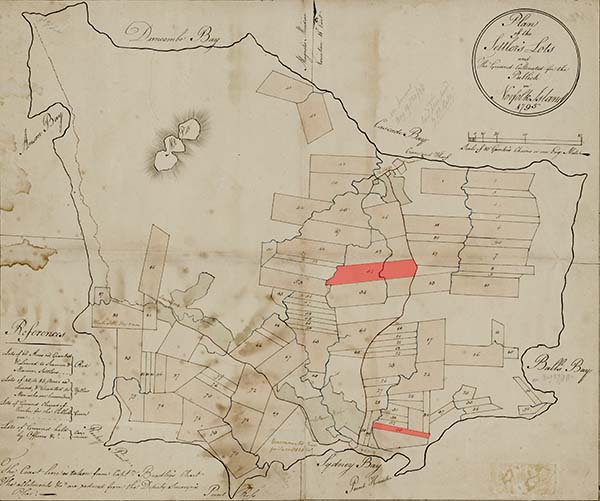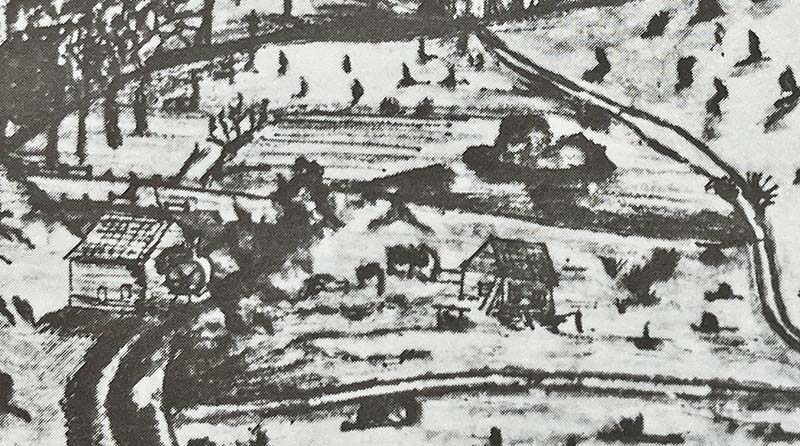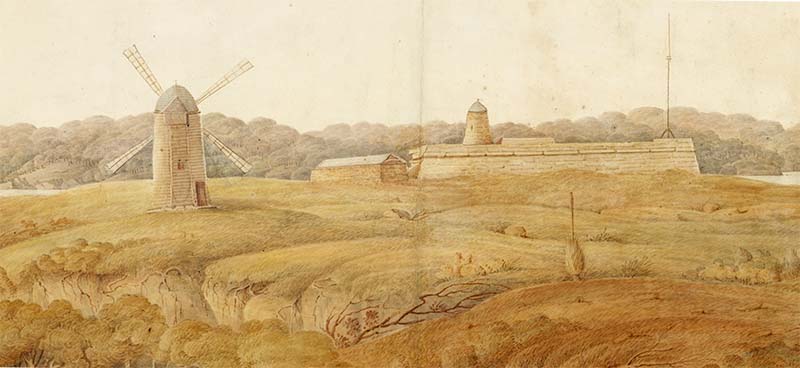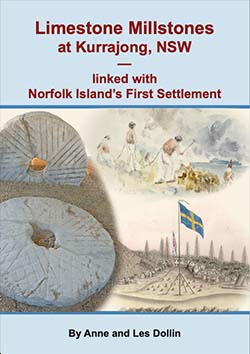
Nathaniel Lucas and Olivia Gascoigne
Built historic flour mills in Norfolk Island and Sydney
Topics: Master-Carpenter, millwright, watermills, windmills.
Singleton Mills homepage > Norfolk Island Flour Milling Overview > Nathaniel Lucas and Olivia Gascoigne
Nathaniel Lucas' early life
Nathaniel Lucas (1764-1818) was born in Surrey, England, the son of a builder, William John Lucas. Nathaniel had learned carpentry and some milling and millwrighting skills in England. In 1784 Lucas was convicted of theft and sentenced to be transported to New South Wales (NSW) for seven years.
Nathaniel Lucas arrived in Sydney Cove, NSW, with the First Fleet in 1788. He was one of fifteen convicts of good character selected to be sent, almost immediately, to Norfolk Island, where an outpost settlement was to be established.

Above, the First Settlement on Norfolk Island in 1790. Painting by George Raper, Natural History Museum, London.
Lucas arrived in Norfolk Island on 6 March 1788 with Lieutenant Philip Gidley King, seven free settlers and the other convicts. One of the female convicts in the group was Olivia Gascoigne (1761-1830). She had been convicted of robbery in 1785 and was sentenced to seven years transportation.
Family life on Norfolk Island
Nathaniel Lucas and Olivia Gascoigne were formally married when Reverend Johnson visited the island in 1791. Together they had 13 children, 11 of whom survived. Tragically, their two twin daughters, Sarah and Mary, were accidently killed in 1792 when a huge Norfolk Island Pine fell on their family home.
After Lucas' sentence expired, the family stayed on at Norfolk Island as settlers. In 1791 Lucas was granted a beautiful, 15 acre portion of land at Grenville Valley, along the back of the main settlement, near where Quality Row is located today. In 1793 he bought another 60 acres of land, and the family produced wheat, maize, and pork.

Above, a plan showing (highlighted in red) the first two portions of land owned by Nathaniel Lucas and his wife, Olivia. The southern 15 acre portion at Grenville Valley was granted to Lucas in 1791, whilst Lucas purchased the northern 60 acre portion in 1793. This 'Plan of the Settlers Lots' was drawn by William Neate Chapman in 1795. State Library of NSW.
Lucas as a carpenter and a millwright
Lucas earned the respect of King and soon became a supervisor of the carpenters. His achievements included many important public buildings on Norfolk Island, such as both the first and second Government House on the island, a vital 32m long wharf with a crane at Cascade Bay, and two windmills and a watermill. King wrote in 1792,
'Nath.l Lucas, who was a convict but has some time ago served the Term of his Transportation, & is settled, has been of the greatest service on this Island as an Overseer & Workman & has been employed since I returned to the island in Superintending the Carpenters. Sawyers, & Blacksmiths & carrying on the buildings. He is a Man of such use in the present necessity for buildings that I was induced to apply to Gov.r Phillip for some recompence for him, who has given me permission (by the Pitt) to return his name as a Superintendent of Convicts'. [1]
According to King, when Lucas first came to Norfolk Island in 1788, he only had general carpentry skills, but with experience Lucas became a respected carpenter and supervisor. He went on to build the island's first flour mills, with much-valued millwright skills.
King wrote in a report to the Colonial Office in London in 1795,
'… the Inhabitants of this Island are indebted to the … Ingenuity of a [?Settler]…, who has served his Term of Transportation. He came to this island when I first settled it. At that time, his abilities as a Carpenter were just sufficient to build a Framed and Weather-boarded Dwelling House. Since then, he has had the Direction of all the Buildings. This Man has been consistently employed as Overseer of the Carpenters….' [2]
…and in a report in 1794 about the first flour mill of the First Settlement, built by Lucas,
'… although the Man did his best, yet it required too great power to work it. If a Mill wright could be sent here to give instruction, any number of overshot Mills might be Erected on the Island'. [3]
… and then in a letter to Paterson in 1795,
' … I have the pleasure to observe that a Millwright is not wanted, as Nath.l. Lucas who I have directed to act as Master Carpenter… has some time back finished an Overshot Water Mill, which will Grind & Boult Sixteen Bushels of Wheat daily, which is more than sufficient to supply the Store with the Weekly Expense of Flour, He is now erecting a Wind Mill for himself, which is nearly finished.' [4]

Above, detail of a drawing of the First Settlement Watermill (far left), that was built by Nathaniel Lucas in Arthur's Vale in 1796. From: 'View of the Water Mill in Arthur's Vale, Norfolk Island', by William Neate Chapman. State Library of NSW.
A letter to his father
In 1796, King returned to England. As a sign of his respect for Lucas, he undertook to deliver a letter to Lucas' father in England for him. Unfortunately for Lucas, the letter was not able to be delivered. However, fortunately for readers today, this fascinating letter was preserved amongst King's papers in the Mitchell Library, Sydney. Some extracts from a transcript of this letter are as follows:
'Dear Father,... My Family at the present time consists of my wife and four children, two boys and two girls. I had the unspeakable misfortune to lose two twin girls by an accident which could it be represented in a proper manner, would awaken the most tender feelings and melt the hardest heart into sympathy. It was by the fall of a Pine Tree which stood near my house which buried my lovely infants in the ruins and almost my worthy partner who merely escaped with her life, for she was dragged out into a situation in which her life was despaired of. Oh! Father I am not able to express the poignant grief I felt on this very shocking scene without dwelling long upon the subject together with the variety of misfortunes liable to those who transgress the Laws of their Country. I can now with truth assert that I have surmounted them all and with the Blessing of God I hope that in the course of two years to return to my native Country with a competency for Life. I am Master Carpenter of this Island for which I receive a salary of Fifty Pounds per annum. I have two Freeholds consisting of 75 acres of Land. I should be wanting very much to Gratitude if I did not acquaint you that my present good fortune is to be imputed in a measure to the humane goodness and assiduous respect of Lieut. Gov. King who has ever promoted my interests since my residence on this Island... I had the honour under the direction of Lieut. Gov. King to construct a water mill for the government and a windmill on my own estate... From |
Later life in Sydney
Nathaniel Lucas never did return to his 'native Country'. Instead, he lived the remainder of his life in Sydney, NSW.
In 1803, King, who by that stage had been appointed Governor of NSW, asked Lucas to come to Sydney to help build a watermill in Parramatta (25 km west of Sydney). After working on that project, Lucas returned to his family in Norfolk Island on the Experiment in 1804.[6]
Then King asked Lucas to move to Sydney permanently. He hoped that, with his proven millwrighting skills, Lucas could solve the acute shortage of flour mills in Sydney.[7]
In March 1805, Lucas arrived in Sydney with his family in the Investigator. Lucas brought with him from Norfolk Island several pairs of millstones and the workings of two windmills.[8]
Calcarenite Limestone Millstones
|
Read more about Norfolk Island millstones
The family settled in inner Sydney. Using the millstones and mill components that he had brought from Norfolk Island, Lucas soon erected a smock-style windmill for the Government near Fort Phillip, and a post mill for himself in the Domain area. He went on to erect another flour post mill on Millers Point, and then later began building two more windmills at Liverpool.

Above left, the smock windmill built by Nathaniel Lucas near Fort Phillip, Sydney Cove in 1805. This was Sydney's third Government Mill and it used millstones quarried on Norfolk Island. In the background on the right can be seen the remains of an earlier Government Windmill. Detail from a painting by Major James Taylor in ca. 1819–1821, 'Parramatta River Sydney Harbour', State Library of NSW.
Lucas was also involved in many building projects in Sydney, including work on the Rum Hospital and church rectories.
In 1809, Lucas was granted a Wine and Spirit Licence, and was running the Trafalgar Hotel that he had built near his smock-style windmill at Sydney Cove. He also became involved in a boat-building enterprise, advertising the sale of two new boats in 1809.[9]
In 1811, Lucas was granted 500 acres of land at Liverpool and this area became the centre of his activities for the next few years. He worked on the construction of his two windmills, a parsonage, and the St Luke's Church in Liverpool.[9]
Nathaniel Lucas' death and legacy
Sadly, Nathaniel Lucas drowned in the Georges River at Liverpool in 1818 aged 54. His headstone in Liverpool Apex Park bears the following inscription:
'He left a widow and large family (consisting of seven sons and four daughters) to lament the loss of a kind husband and an indulgent father.' [10]
Some of Nathaniel Lucas' sons also became prominent mill builders:
– John Lucas built two flour mills at Holsworthy and Woronora River, NSW.[11]
– Robert Lucas and Nathaniel Lucas (junior) built a windmill at Port Dalrymple, Tasmania.[12]
Nathaniel Lucas left a notable legacy as one of the best early millwrights of Australia, who built vital flour mills for the first colonial settlements at Norfolk Island and Sydney.
REFERENCES
Abbreviations:
CO – Colonial Office Records 1774-1951.
HRA – Historical Records of Australia. https://nla.gov.au/nla.obj-442186184
1. CO, 201.9, page 95. https://nla.gov.au/nla.obj-913863450/view
2. CO, 201.18, page 36. https://nla.gov.au/nla.obj-914313754/view
3. CO, 201.10, page 264. https://nla.gov.au/nla.obj-914011294/view
4. CO, 201.18, page 28. https://nla.gov.au/nla.obj-914312717/view
5. https://australianroyalty.net.au/tree/purnellmccord.ged/individual/I69917/Nathaniel-Lucas
6. HRA, Series 1, Vol 5, page 221 (enclosure dated 1 October 1804).
7. HRA, Series 1, Vol 5, page 172. 20 December 1804
8. The Sydney Gazette and New South Wales Advertiser, 17 March 1805.
9. Langström, Trevor M (2008) Prisoners in Paradise. The story of Olivia Gascoigne & Nathaniel Lucas. Published by Trevor and Judi Langström.
10. https://www.findagrave.com/memorial/170747214/nathaniel-lucas
11. Forbes, Pam and Jackson, Greg (2012) Watermills of John Lucas: Part 1. Sutherland Shire Historical Society Inc Bulletin, 15 (3): 17-24.
12. The Hobart Town Gazette and Southern Reporter, 17 May 1817.
Read More About Norfolk Island's Flour Mills
•• Overview •• First Settlement Flour Mills •• Second Settlement Flour Mills •• Nathaniel Lucas •• Robert Nash •• Norfolk Island Millstones ••
